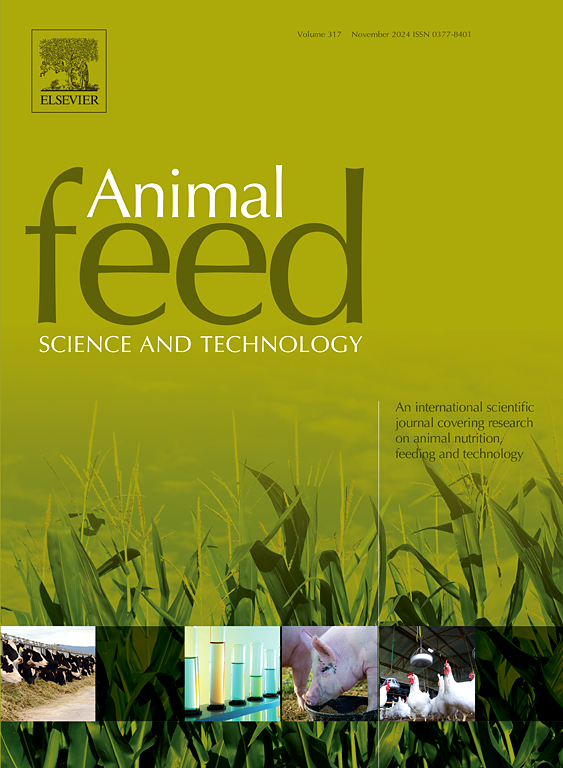Condensed tannins from black wattle as a promising nutritional additive for Nile tilapia: Growth, immune and antioxidant responses, and gut morphology
IF 2.5
2区 农林科学
Q1 AGRICULTURE, DAIRY & ANIMAL SCIENCE
引用次数: 0
Abstract
The present study aimed to investigate the potential of condensed tannins (CT), derived from black wattle (Acacia mearnsii) tree bark, as a nutritional additive for Nile tilapia (Oreochromis niloticus) juveniles. CT are known for their antioxidant and immune-modulating properties, and their inclusion in aquafeeds may enhance fish health and performance. In this study, six diets were formulated: one control diet (Con) with no additives, and five experimental diets supplemented with CT extract at concentrations of 150, 250, 500, 750, and 1000 mg/kg (CT150, CT250, CT500, CT750, CT1000, respectively). The selection of these doses was based on previous studies indicating that lower concentrations (below 1000 mg/kg of diet) of tannins may offer benefits, while higher concentrations could exhibit antinutritional effects. After a 90-day feeding trial, fish fed the CT150 diet exhibited significantly higher growth compared to the control group. Additionally, fish in the CT150 group showed higher plasma lysozyme activity, while myeloperoxidase activity and hemolytic activity of the complement system were significantly higher in all tannin-fed groups compared to the control. Notably, CT150-fed fish demonstrated liver antioxidant responses comparable to or better than the control group, with no significant increase in lipid peroxidation, suggesting antioxidant protection. Histological analysis revealed a significant increase in intestinal villi density in the CT150 and CT500 groups compared to the control. While all groups showed an increase in absorption surface area (ASA), this increase was statistically significant only in the CT250, CT500, and CT750 groups when compared to the control. Furthermore, the CT150 diet led to the highest survival rate (80 %) following a bacterial challenge. These findings suggest that dietary supplementation with 150 mg/kg of CT from black wattle bark provides the most beneficial effects on growth, immune response, and survival in Nile tilapia juveniles.
将黑荆条中的缩合单宁作为尼罗罗非鱼的一种有前景的营养添加剂:生长、免疫和抗氧化反应以及肠道形态学
本研究旨在调查从黑荆树(Acacia mearnsii)树皮中提取的缩合单宁(CT)作为尼罗罗非鱼(Oreochromis niloticus)幼鱼营养添加剂的潜力。众所周知,CT 具有抗氧化和免疫调节的特性,将其添加到水产饲料中可提高鱼类的健康和生产性能。本研究配制了六种日粮:一种是不含任何添加剂的对照日粮(Con),另五种是添加 CT 提取物的实验日粮,浓度分别为 150、250、500、750 和 1000 毫克/千克(CT150、CT250、CT500、CT750 和 CT1000)。选择这些剂量的依据是先前的研究表明,较低浓度(低于每公斤食物 1000 毫克)的单宁酸可能会带来益处,而较高浓度的单宁酸可能会产生抗营养作用。经过 90 天的喂养试验,与对照组相比,喂养 CT150 日粮的鱼的生长速度明显提高。此外,与对照组相比,CT150 组的鱼血浆溶菌酶活性更高,而髓质过氧化物酶活性和补体系统的溶血活性在所有鞣酸喂养组中都明显更高。值得注意的是,喂食 CT150 的鱼的肝脏抗氧化反应与对照组相当或更好,脂质过氧化反应没有明显增加,这表明抗氧化保护作用。组织学分析表明,与对照组相比,CT150 和 CT500 组的肠绒毛密度明显增加。虽然所有组的吸收表面积(ASA)都有所增加,但与对照组相比,只有 CT250、CT500 和 CT750 组的吸收表面积增加具有统计学意义。此外,CT150 日粮在细菌挑战后的存活率最高(80%)。这些研究结果表明,日粮中添加 150 毫克/千克的黑荆树树皮 CT 对尼罗罗非鱼幼鱼的生长、免疫反应和存活率有最大的益处。
本文章由计算机程序翻译,如有差异,请以英文原文为准。
求助全文
约1分钟内获得全文
求助全文
来源期刊

Animal Feed Science and Technology
农林科学-奶制品与动物科学
CiteScore
6.00
自引率
6.20%
发文量
266
审稿时长
3 months
期刊介绍:
Animal Feed Science and Technology is a unique journal publishing scientific papers of international interest focusing on animal feeds and their feeding.
Papers describing research on feed for ruminants and non-ruminants, including poultry, horses, companion animals and aquatic animals, are welcome.
The journal covers the following areas:
Nutritive value of feeds (e.g., assessment, improvement)
Methods of conserving and processing feeds that affect their nutritional value
Agronomic and climatic factors influencing the nutritive value of feeds
Utilization of feeds and the improvement of such
Metabolic, production, reproduction and health responses, as well as potential environmental impacts, of diet inputs and feed technologies (e.g., feeds, feed additives, feed components, mycotoxins)
Mathematical models relating directly to animal-feed interactions
Analytical and experimental methods for feed evaluation
Environmental impacts of feed technologies in animal production.
 求助内容:
求助内容: 应助结果提醒方式:
应助结果提醒方式:


